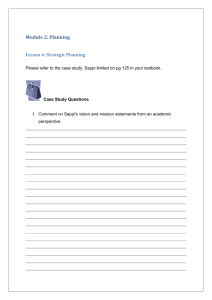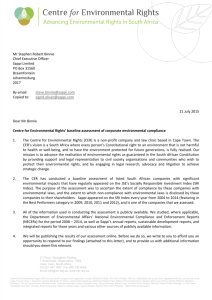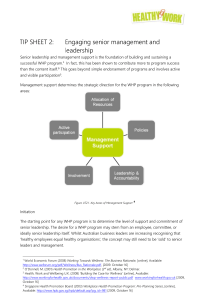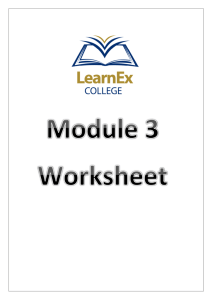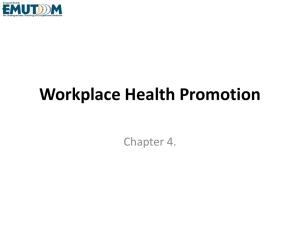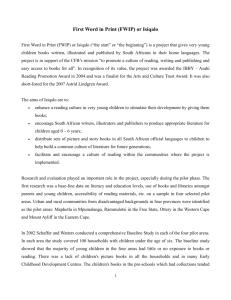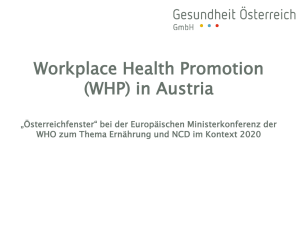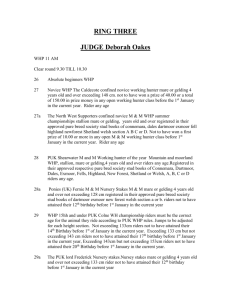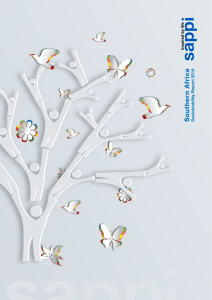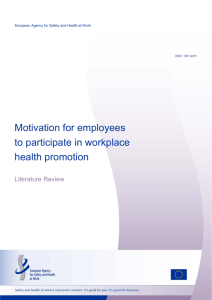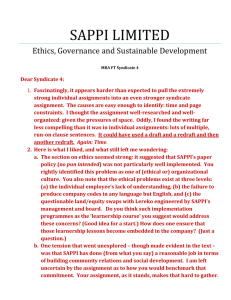Best Practice Example - ENWHP European Network For Workplace
advertisement
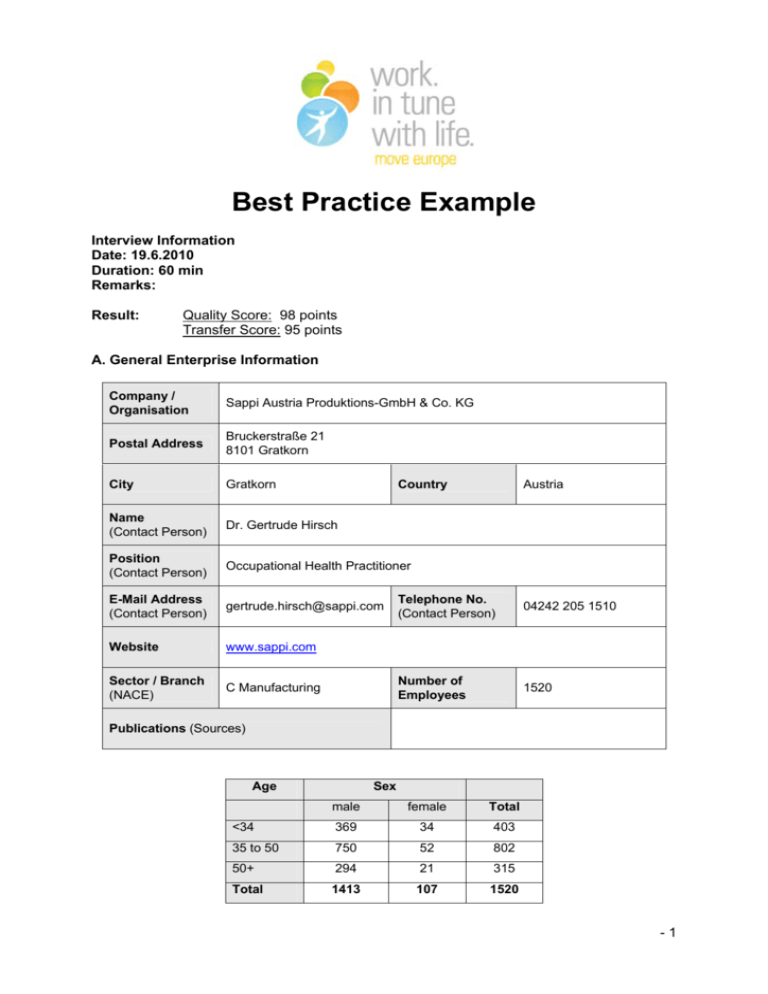
Best Practice Example Interview Information Date: 19.6.2010 Duration: 60 min Remarks: Result: Quality Score: 98 points Transfer Score: 95 points A. General Enterprise Information Company / Organisation Sappi Austria Produktions-GmbH & Co. KG Postal Address Bruckerstraße 21 8101 Gratkorn City Gratkorn Name (Contact Person) Dr. Gertrude Hirsch Position (Contact Person) Occupational Health Practitioner E-Mail Address (Contact Person) gertrude.hirsch@sappi.com Website www.sappi.com Sector / Branch (NACE) C Manufacturing Country Austria Telephone No. (Contact Person) 04242 205 1510 Number of Employees 1520 Publications (Sources) Age Sex male female Total <34 369 34 403 35 to 50 750 52 802 50+ 294 21 315 Total 1413 107 1520 -1 B. Policy & Corporate Culture: Description (max. 500 words) In 2001, the Sappi company decided to place a strong future focus on the area of “Workplace Health Promotion” (WHP). The project “Healthy Future” was started and stood under the motto “Healthy employees in a healthy company” with the declared goal of sustainably incorporating the developed measures into the company beyond the duration of the project. In the meantime, the project has been completed. “Healthy Future” will be continued by the company as a meaningful process. A long-term basis for the health and well-being of all employees was thereby created. Sappi has committed itself to the mission statement formulated in the steering committee at the beginning of workplace health promotion. The firms abides by the holistic health definition of the WHO, which says: for us, health protection and health promotion mean to create conditions to maintain, promote or even to improve the physical, mental and social wellbeing of our employees. Over and above this mission statement, the company attempts to offer its staff a wide range of consciousness- and personality-building measures that go beyond the usual scope and surely have a further effect in employees’ private lives. The Human Work Index – The Measuring Instrument: “We remain healthy, active and long in the work process if we can, want to and are allowed to”. The core piece of the employee survey is the Human Work Index (HWI), which is standardized and tested for the dimensions of coping with work, interest in the work itself and teamwork. The value of the total index of the three partial indices is each indicated in %, whereby 100% means the maximum. Serving as the starting point was an employee survey in 2002 about the Human Work Index, upon whose results the numerous activities and measures of the following years are based. Since then, this survey has been repeated in regular intervals (2005 and the beginning of 2010). It offers valuable indications of already attained improvements and allows for an even more targeted controlling of the next steps. On the basis of these results, numerous measures were developed in the following areas: work-life balance; social competence; team development; stress management; communication and conducting discussions; nutrition; movement; workplace design / dealing with stress factors; addiction prevention; health care; age-appropriate working conditions. Some of the biggest stress factors in working life are problems in co-operating, not only between manager and employee, but also between employees of the same hierarchical level. If coping with work and interest in the work can unfold in a working climate that is good and collegial, in a company which involves its employees and with executives that value the -2 employees, then we speak of good co-operation. The working climate, the sense of togetherness and the personal level of teamwork in one’s profession are closely linked. Opportunities to shape the company, satisfaction with the relationships within the team, and the promotion of personal development play a large role here. This can also be measured well by the co-operation index. Since the beginning of WHP, Sappi has been dealing with the topic of mental health; since 2008, an emphasis has been placed on burn out prevention and a three-step concept was developed. In addition, an increasing number of seminars especially concerned with mental health will be offered. -3 C. Organisation & Structure: Description (max. 500 words) The QHSSE Steering Committee decides on goals, strategy, projects and budget concerning the topics of Quality, Health, Safety, Security and Environment. The steering committee meets at least every two months and makes all the decisions about workplace health promotion, specifies goals and sets up working circles. As it is the highest decisionmaking body, it has all the competences and resources and can increase these if required by involving internal and external advisors. The goals are evaluated at least once a year, and there are regular reviews. If necessary, the goals will be adjusted. The promotion of mental health in the company is also a task of the QHSSE Steering Committee. On the topic of mental health, an individual working circle for the management team, which is concerned with information and reflexion, was additionally set up. Members of the QHSSE Steering Committee are the plant director, the management team (that is, all the division heads), the safety expert, the occupation health practitioner, personnel development and on occasion, the works council. The budget is available in the different areas by means of the division budget, as well as by the personnel development and the company doctor’s office. Moreover, personnel development and the company doctor’s office have sufficient resources for the organization of the planned measures. Subsequently following is a listing of people in the company who are entrusted with health topics: Occupational Health Service (Dr. Gertrude Hirsch, MTF Angelika Wener) * Tasks: Preventive medicine; occupational medicine; involvement in the three-step concept for burn out prevention; organization of health seminars and lectures; leading the health team; leading the health confidants; member of the steering committee * Competences and resources: Using one’s own available competences and resources, further education possibilities will be strongly promoted by the company; external experts will be engaged for different topics; organization of lectures seminars and other health events; strategy development on the topic of WHP with the management team and members of the works council; networking with other companies about the topic WHP; own budget Personnel Development (Mag. Jürgen Sicher, Gabriele Schilling) * Tasks: Steering; evaluation; advising of the management; development and evaluation of the Human Work Index survey; formulation of competences for WHP -4 * Competences and Resources: Budget responsibility for the most part for the WHP topics and measures; HWI surveys (2002, 2005, 2010): preparation and carrying out the employee surveys about Human Work Index, processing the results for employees and management, supporting management for communicating the results as well as the planning of implementation measures; allocating the budget for the planned implementation; selection of external experts (advisors, trainers for workshops, training sessions and organisational development processes); networking with other companies about the topic WHP; evaluation of the individual measures and the complete WHP process; strategy development about the topic WHP with the management team and members of the works council All Managers (Plant Director Dr. Max Oberhumer and his management team) and Key Persons (Safety Expert) * Tasks: Member of the Steering Committee; development of overriding health goals of the location; development of health goals in the individual areas; contact partners of the health confidants in the areas; role model function * Competences and Resources: Deciding over the budget in one’s own area of responsibility; goal formulation; applying for internal and/or external support for personnel development or occupational health service Health Confidants as Multipliers Since 2004 there have been 62 health confidants, including apprentices (2). They come from all areas, are blue-collar workers (38) and white-collar workers (22), women and men, people for whom the topic of health is near and dear. They have all received a four-day further training and are multipliers in order to assure a plant-wide and shift-spanning continuous flow of information from the top down as well as from the bottom up. The activity takes place voluntarily and is fully and completely supported by management. The concept of health confidants developed by Sappi has been adopted by the Austrian paper industry. The paper making school in Steyrermühl offers training for health confidants based on seminars especially developed for Sappi with Humanware. -5 D. Implementation: Description (max. 500 words) Since the beginning of workplace health promotion, the company has been dealing with the topic of mental health. Burn out prevention has been a major focus since 2008. A 3-step concept was developed at Sappi: 1. Prevention: y Seminars and lectures (including Stress Management – Dealing with Stress; Body and Soul – Gathering Powers for Everyday Life; Qi Gong; Private Relationships of Busy People – Systematic Problems and Simple Solutions; Health Risk Sleep Disturbance – Whoever Is Tired Makes Mistakes; Mental Training – How to Learn to Command the Power of Thoughts; Chair Massage – Relaxation and Recharging with Fresh Energy in only 20 Minutes; Energy Management; Success with Energy Management) y Health talk with IBS (Inspiration of Business & Sports) by two employees of an external consulting firm: in individual discussions over a period of four to six months, the employees will receive an on-site relief programme tailor-made for the work process and, at the same time, a high degree of trust will be built up in these contacts, making it possible to be responsive to various professional, private and personal problems, worries and hardships of employees. When necessary and upon the employee’s request, the suitable consulting offer for the particular problem will be exactly researched and the employee can, in further consequence, get the necessary support (e.g., burn out, mobbing, divorce, parenting advice, conflict counselling, etc.). Health topics ease the entrance into various other topics, such as, e.g., mental problems. It is much simpler for many people to admit that they have back pains than to admit they suffer from depression, stress symptoms or panic attacks. The employees will be continuously looked after; each employee will be personally contacted every four to six weeks and physical and mental concerns can be addressed. 2. Raising Awareness: Information and development of social competences of managers: y Situational Leadership: Programme for manager development. The main focus of manager development lies in the introduction of a leadership instrument agreed upon for all of Europe – Situational Leadership (SLII). This 3-day programme was especially designed for Sappi and carried out in co-operation with Mailleaux and Associates”. It supports managers in the development of their employees into autonomous experts. The contents of the seminar series are, amongst others: situational leadership, appreciative -6 conversation techniques, recognition and critical discussion, dealing with personal, resp., private problems of employees, self-reflection and stress load in the leadership function. In Gratkorn approx. 140 managers took part in this programme from May 2008 to April 2010. y Regular information and reflection seminar of the management team with Prim. Dr. Dr. Michael Lehofer. 3. Crisis Intervention: y Managers support employees in crises cases. Sappi offers individual and needs-based coaching or psychotherapy in crisis cases. The planning of measures is based on the Human Work Index employee survey that is conducted regularly. This instrument allows for a needs analysis and an evaluation of WHP measures. In addition to the measures for mental health, numerous behavioural- and circumstantially-oriented measures in the areas of workplace design, movement, nutrition, social competence, health care / health checks, work-life balance, addiction prevention and age-appropriate working were and will be carried out. These activities are not only aimed at our whole staff, blue-collar and white-collar workers (most of the measures are free for the participants, a small individual fee will be charged for only a few of them), but also involve our retired employees, the family members of employees and, in some measures (e.g. the topic of addiction and addiction prevention), even the whole community of Gratkorn. It is a matter of course that health problems are to be handled in confidence, no matter if it concerns physical or mental suffering. This principle will be lived not only by the occupation health practitioner (professional discretion), but also by the responsible persons in the human resources department and the works council. If desired, a rehabilitative stay with the focus on mental health, e.g., in Bad Aussee or in St. Radegund, will be arranged. If the employee allows it, he/she will also be accompanied during the sick leave, whether it is in the form of telephone calls or personal talks. A possible adaptation of the working place occurs under consideration of the employee’s wishes. In the case of mobbing, the occupational health practitioner, if the employee allows it, will arrange a discussion with the superior and the concerned party in order to plan possible future steps together. For serious mental illnesses, e.g., endogenous depression, the working place will be adapted to the particular possible job performance. -7 E. Evaluation: Description (max. 500 words) The company evaluates the taken measures, on one hand, through regular Human Work Index employee surveys. In addition, the health goals will be regularly scrutinised and evaluated in the reviews of the steering committee. A sick leave management will be conducted, and the company has set an ambitious goal of a health quotient of more than 45%. If necessary, the individual measures will be evaluated by external partners, such as, e.g., the introduction of health confidants and their training. Employee involvement occurs through recurring surveys of the Human Work Index with subsequent workshops in all departments with all employees (presentation of the department results and an ascertainment of needed changes). Furthermore, there are 62 health confidants as multipliers, who assure a plant-wide and shift-spanning continuous flow of information from the top down as well as from the bottom up. In addition, the topic of mental health is anchored in the employee performance reviews, and health audits will be conducted. Through the company health management at Sappi, a long-term basis for the health and well-being of all employees was created. The increase of individual indices and key data in the HWI survey are particularly measurable in departments where concerted measures were implemented for selected topics. Health awareness has generally risen (measurable, e.g., in the increased participation in various health events; the heightened demand for health activities; the increased utilisation of night shift meals; heightened frequenting of the occupational health practitioner’s office for counselling and preventive medicine issues). The most important success factors are: the involvement of all managerial levels, the works council, personnel development and occupation health practitioners, the role model effect of managers; the involvement of health confidants who serve as multipliers; the retention of the health team for the organisation of health events; the addressing of health issues directly at the workplace by trained external advisors; the allocation of a budget for WHP; the involvement of the employees, e.g., through surveys. The most significant stumbling blocks / complicating factors are: “troubles of the plateau” – this means that everything is new and suspenseful at the beginning of a WHP project. How does one keep up the suspense? How does one keep the health topic alive when one already works at a high level? And how does one consistently find relevant buttons to push to particularly get managers enthused about the topic also in times of economic crisis? Aside -8 from having too little time, too little budget, too little involvement of middle management? One should not count on the fact that something was decided from above and will also be carried out then. A further difficulty is the shifting of priorities due to outside circumstances (e.g., economic crisis). Mag. (FH) Roland Kaiser, MSc Department of General Policy Matters, Legal Affairs and Organisation Health Promotion and Public Health Tel. 0043 (0)316 8035 - 1481 Fax 0043 (0)316 8035 - 661481 roland.kaiser@stgkk.at -9
